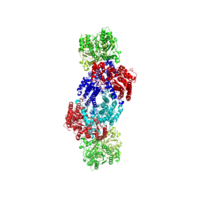
Photo from wikipedia
Hydrazine (N2H4) is produced at industrial scale from the partial oxidation of ammonia or urea. The hydrogen content (12.5 wt%) and price of hydrazine make it a good source of… Click to show full abstract
Hydrazine (N2H4) is produced at industrial scale from the partial oxidation of ammonia or urea. The hydrogen content (12.5 wt%) and price of hydrazine make it a good source of hydrogen fuel, which is also easily transportable in the hydrate form, thus enabling the production of H2in situ. N2H4 is currently used as a monopropellant thruster to control and adjust the orbits and altitudes of spacecrafts and satellites; with similar procedures applicable in new carbon-free technologies for power generators, e.g. proton-exchange membrane fuel cells. The N2H4 decomposition is usually catalysed by the expensive Ir/Al2O3 material, but a more affordable catalyst is needed to scale-up the process whilst retaining reaction control. Using a complementary range of computational tools, including newly developed micro-kinetic simulations, we have derived and analysed the N2H4 decomposition mechanism on the Cu(111) surface, where the energetic terms of all states have been corrected by entropic terms. The simulated temperature-programmed reactions have shown how the pre-adsorbed N2H4 coverage and heating rate affect the evolution of products, including NH3, N2 and H2. The batch reactor simulations have revealed that for the scenario of an ideal Cu terrace, a slow but constant production of H2 occurs, 5.4% at a temperature of 350 K, while the discharged NH3 can be recycled into N2H4. These results show that Cu(111) is not suitable for hydrogen production from hydrazine. However, real catalysts are multi-faceted and present defects, where previous work has shown a more favourable N2H4 decomposition mechanism, and, perhaps, the decomposition of NH3 improves the production of hydrogen. As such, further investigation is needed to develop a general picture.
Journal Title: Faraday discussions
Year Published: 2017
Link to full text (if available)
Share on Social Media: Sign Up to like & get
recommendations!